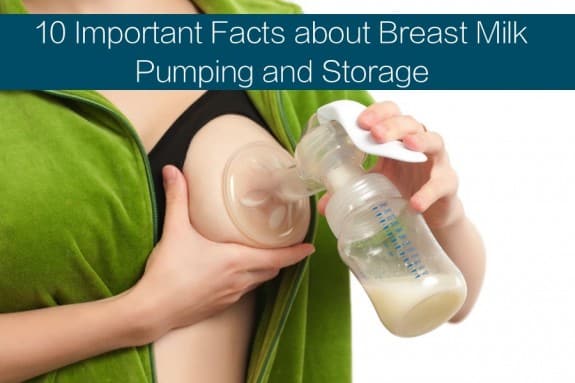Before you start pumping and storing breast milk, there are some important tips you should know. Relied upon by veteran breastfeeding moms, they are designed to help ensure that your milk is both safe and contaminant-free for when you need it. So, whether you’re doing it so that you can return to work, or you just want to be sure you have some on hand for mommy days or date nights, take note of these 10 important facts about breast milk pumping and storage.
Pumping:
- From your hands to your bottles, to your breast pump and its internal parts, it’s important to keep things clean! Sterilize bottles and all parts of your pump before first use. Then, after each use, always wash your pump, pump parts, and bottles with hot, soapy water. And, before you sit down to pump, be sure to wash your hands with warm soap and water.
- Practice makes perfect, and there’s nothing worse than being under pressure to hurry up and produce right before the milk is needed. Take some time in the early weeks—particularly when you’re prone to engorgement—to sit and pump when you’re feeling relaxed and calm. It’s best if you try to do so for just a few minutes before your baby wakes up for a feeding, or if he/she has skipped a feeding. It’s also best if you give yourself at least one to two weeks to build up your back supply of milk before returning to work.
- Unless your child has a medical condition that prohibits breastfeeding, you should continue to nurse when you can. This helps to preserve both your milk supply and your bond with your baby.
- When working, take your pump to work. Pump at least three times a day for an eight hour shift (or about every three hours you’re away from your baby). Whether it’s ten minutes or fifteen minutes, try to get as much milk as you can during those breaks. This will help lessen the chances of meeting your baby’s supply demands.
- If at all possible, try to wait at least three to four weeks before offering a bottle to your baby. While some do perfectly fine between nipple exchange before then, some may have difficulties going from breast to bottle if done too soon. If you’re having any troubles nursing, be sure to contact a health care provider or a lactation consultant near you.
- Breast milk may be different colors, scents, and consistencies from one pumping to the next. This is perfectly normal! But you should watch for fore and hind milk. Fore milk is going to be watery; it is generally the first milk you produce when pumping. This satisfies baby’s thirst and need for liquid. The hind milk, which is a thicker, creamier consistency, contains the fat, which helps baby put on weight. It generally comes after the fore milk, and may even require you to continue pumping for a few minutes after you’ve stopped producing fore milk before any is produced.
Storage:
- Always use a sterile container to store milk. There are special bags that you can purchase, but sterile (non-banded) drop-ins will work as well. Leave a little bit of extra room at the top of the bag before sealing tightly to avoid overflow or bursting. Date milk and then place new milk behind old milk so that you remember to use older milk first.
- You may either refrigerate or freeze breast milk. As long as you store it in the back of the refrigerator (where it is coolest), freshly expressed breast milk can be refrigerated and then used for up to five to eight days. Frozen breast milk can be stored for three to six months in a standard refrigerator freezer, and six to twelve months if stored in a chest freezer. Again, this must be freshly expressed, and it should be stored at the back, away from the door.
- To thaw frozen breast milk, place it in the refrigerator overnight (or until completely defrosted). It can be held over in the refrigerator for up to five days at this point. When you need to warm it, you may run the milk bag under hot water until it reaches the desired temperature. Do NOT place frozen milk under hot water. If you need thawed milk in a pinch, thaw it under cool water to raise the temperature gradually. Once it has thawed, you may increase the temperature of the water.
- Stored milk will also separate, and you’re like to find that the thicker milk is at the top. Gently swirl the warmed milk inside the bottle gently to mix it. Remember to discard any breast milk left over after the feeding. Do not refrigerate again, and do not reheat because this breeds bacteria and reduces the milk’s nutrients. Keep this in mind when creating your storage backs—less is sometimes more because you can always heat up another bag.








Very informative article! Thank you for your pieces of advice about pumping and storage! Greetings, Storage Crossness Ltd.
Your Favorite Breast Pump?
I am 32 weeks pregnant and trying to get ready for whenver our baby decides to come…. I think I have everything minus a pump… But I want to spend my money wisely. So what are your suggestions on a good affordable breast pump, manual or auto? This is all so new to me and I feel overwhelmed. Any help is very much appreciated…. Also what are the best bottles to buy after I pump my milk? Thanks.